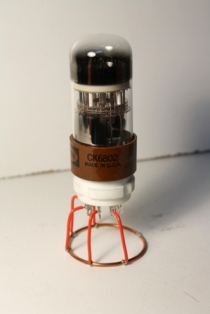Intro
A dekatron spinner is a small, line-powered circuit that is used to make a visual display of the old counting tubes called dekatrons. Dekatrons are gas filled discharge tubes so if the fill gas is neon, the glow on the cathodes is red-orange and if argon, it’s violet. Normal dekatrons have fairly low count speed from 1 to 100 thousand counts per second. The rare ones that are hydrogen filled can be driven at a much higher rate.
Dekatrons commonly have 30 electrodes arranged around a central anode. In double pulse tubes with 30 electrodes, 10 of them are actual cathodes and between each of them are two glow transfer electrodes. These are used to move the glow from one cathode to the other. They are biased positively so that the “glow” will rest on the actual cathode and to move it, they are biased negatively. The negative bias doesn’t need to be all that great since the “glow” only needs to move a small distance to the glow transfer electrode. There are two electrodes to prevent the glow from going back to the electrode from which it came. The “glow” doesn’t move itself around the tube. Instead, it’s the ionized gas portion that changes position but the actual atoms/ions don’t move much.
Where is/was it Used?
Dekatrons used to be used in calculators and computers for arithmetic. They are similar to a ring counter of neon lamps but are a single device, can normally count faster, can count in either direction, and are easier to use. Neon lamp ring counters have the advantage of being able to divide a signal by other whole numbers though.
How I Came Across This and why I Built it
I was interested in vacuum tubes and was looking for circuits that used the “magic- eye” tubes. Those projected electrons onto a phosphor target. While looking into those, I found many other devices such as nixie tubes, photomultipliers, beam- switching tubes, and dekatrons. The dekatron spinner looked like a really easy circuit to build, get results, and learn about old technologies.
Design and Construction
Since I can easily get common octal sockets from my local electronics store, I purchased the CK6802.

I wanted to see the spinner work before adding on to it. I used the design seen here.
I used a point to point design because it’s enjoyable to try to make something look pretty as well as function. However, when I connected it all up to the dekatron, it didn’t spin. Instead, the glow just rested on one cathode. It may be because the dekatron wasn’t designed to handle small differences in phase shifts but this is only a guess.
I may retry the first phase shift design but I had better success with this phase shift design.
This point to point wiring was a lash up but since it worked, I kept it this way. If and when it does make it into the final design, it will be remade to look nicer. (3/13/09)